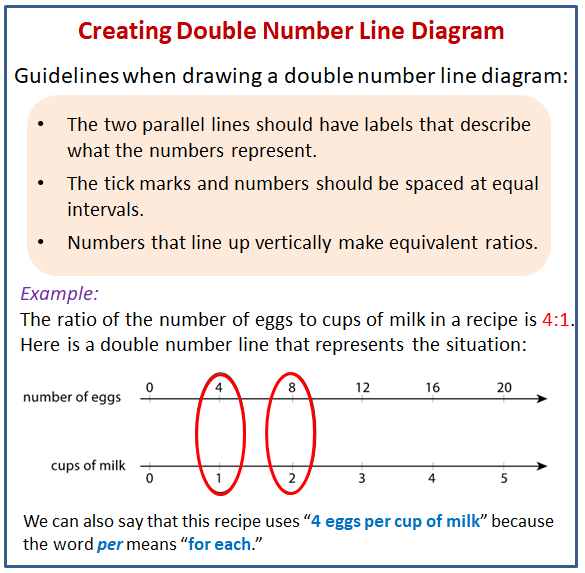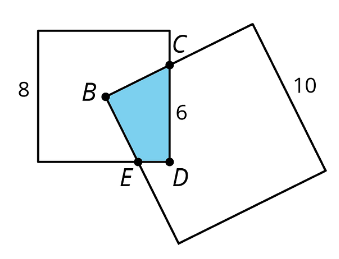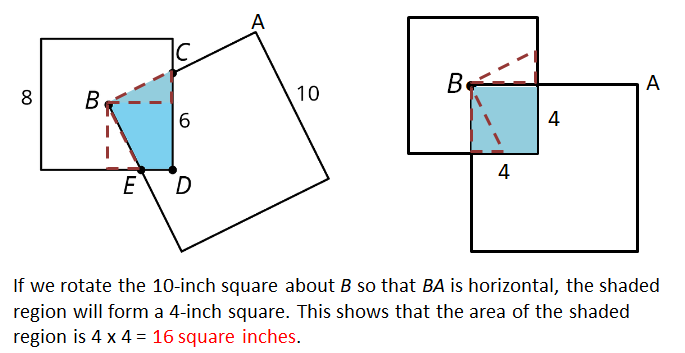Illustrative Mathematics Unit 6.2, Lesson 7: Creating Double Number Line Diagrams
Learning Targets:
- I can create a double number line diagram and correctly place and label tick marks to represent equivalent ratios.
- I can explain what the word “per” means.
Related Pages
Illustrative Math
Grade 6
Lesson 7: Creating Double Number Line Diagrams
Let’s draw double number line diagrams like a pro.
Illustrative Math Unit 6.2, Lesson 7 (printable worksheets)
Lesson 7 Summary
The following diagram shows how to create a double number line diagram.

7.1 Ordering on a Number Line
-
Locate and label the following numbers on the number line:
-
Based on where you placed the numbers, locate and label four more fractions or decimals on the number line.
Scroll down for the answer to area of overlapping squares.
7.2 - Just a Little Green
The other day, we made green water by mixing 5 ml of blue water with 15 ml of yellow water. We want to make a very small batch of the same shade of green water. We need to know how much yellow water to mix with only 1 ml of blue water.
- On the number line for blue water, label the four tick marks shown.
- On the number line for yellow water, draw and label tick marks to show the amount of yellow water needed for each amount of blue water.
- How much yellow water should be used for 1 ml of blue water? Circle where you can see this on the double number line.
- How much yellow water should be used for 11 ml of blue water?
- How much yellow water should be used for 8 ml of blue water?
- Why is it useful to know how much yellow water should be used with 1 ml of blue water?
7.3 - Art Paste on a Double Number Line
- Follow the instructions to draw a double number line diagram representing the recipe for art paste.
a. Use a ruler to draw two parallel lines.
b. Label the first line “pints of water.” Label the second line “cups of flour.”
c. Draw at least 6 equally spaced tick marks that line up on both lines.
d. Along the water line, label the tick marks with the amount of water in 0, 1, 2, 3, 4, and 5 batches of art paste.
e. Along the flour line, label the tick marks with the amount of flour in 0, 1, 2, 3, 4, and 5 batches of art paste. - Compare your double number line diagram with your partner’s. Discuss your thinking. If needed, revise your diagram.
- Next, use your double number line to answer these questions:
a. How much flour should be used with 10 pints of water?
b. How much water should be used with 24 cups of flour?
c. How much flour per pint of water does this recipe use?
Are you ready for more?
A square with side of 10 units overlaps a square with side of 8 units in such a way that its corner B is placed exactly at the center of the smaller square. As a result of the overlapping, the two sides of the large square intersect the two sides of the small square exactly at points C and E, as shown. The length of CD is 6 units. What is the area of the overlapping region CDEB?

7.4 - Revisiting Tuna Casserole
The other day, we looked at a recipe for tuna casserole that called for 10 ounces of cream of chicken soup for every 3 cups of elbow-shaped pasta.
- Draw a double number line diagram that represents the amounts of soup and pasta in different-sized batches of this recipe.
- If you made a large amount of tuna casserole by mixing 40 ounces of soup with 15 cups of pasta, would it taste the same as the original recipe? Explain or show your reasoning.
- The original recipe called for 6 ounces of tuna for every 3 cups of pasta. Add a line to your diagram to represent the amount of tuna in different batches of casserole.
- How many ounces of soup should you mix with 30 ounces of tuna to make a casserole that tastes the same as the original recipe?
Glossary Terms
per
The word per means “for each.” For example, if the price is $5 per ticket, that means you will pay $5 for each ticket. Buying 4 tickets would cost $20, because 4 • 5 = 20.
Lesson 7 Practice Problems
- A recipe for cinnamon rolls uses 2 tablespoons of sugar per teaspoon of cinnamon for the filling. Draw the double number line diagram to show the amount of cinnamon and sugar in 3, 4, and 5 batches.
- One batch of meatloaf contains 2 pounds of beef and 1/2 cup of bread crumbs. Draw the double number line diagram to show the amounts of beef and bread crumbs needed for 1, 2, 3, and 4 batches of meatloaf.
- A recipe for tropical fruit punch says, “Combine 4 cups of pineapple juice with 5 cups of orange juice.”
a. Create a double number line showing the amount of each type of juice in 1, 2, 3, 4, and 5 batches of the recipe.
b. If 12 cups of pineapple juice are used with 20 cups of orange juice, will the recipe taste the same? Explain your reasoning.
c. The recipe also calls for 1/3 cup of lime juice for every 5 cups of orange juice. Add a line to your diagram to represent the amount of lime juice in different batches of tropical fruit punch. - One batch of pink paint uses 2 cups of red paint and 7 cups of white paint. Mai made a large amount of pink paint using 14 cups of red paint.
a. How many batches of pink paint did she make?
b. How many cups of white paint did she use? - a. Find three different ratios that are equivalent to the ratio 3:11.
b. Explain why your ratios are equivalent.
Here is a diagram that represents the pints of red and yellow paint in a mixture. - Select all statements that accurately describe the diagram.
A. The ratio of yellow paint to red paint is 2 to 6.
B. For every 3 pints of red paint, there is 1 pint of yellow paint.
C. For every pint of yellow paint, there are 3 pints of red paint.
D. For every pint of yellow paint there are 6 pints of red paint.
E. The ratio of red paint to yellow paint is .
The Open Up Resources math curriculum is free to download from the Open Up Resources website and is also available from Illustrative Mathematics.
Try the free Mathway calculator and
problem solver below to practice various math topics. Try the given examples, or type in your own
problem and check your answer with the step-by-step explanations.

We welcome your feedback, comments and questions about this site or page. Please submit your feedback or enquiries via our Feedback page.



